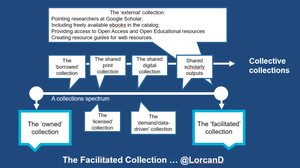The Research Information Network in the UK has released a report about the impact of e-journals …
‘E-journals: their use, value and impact’ takes an in-depth look at how researchers in the UK use electronic journals, the value they bring to universities and research institutions and the contribution they make to research productivity, quality and outcomes. [E-journals: their use, value and impact | RIN]
The report is based on work by CIBER at the University of London. They examine the use of ScienceDirect and Oxford Journals at ten research institutions across several selected subjects.
The report is rich, and I won’t try to summarize it here. It is worth reading in full. Some highlights for me were …
They characterize the scale of the UK e-journal market as follows …
- UK universities and colleges spent nearly £80 million licensing electronic journals
in 2006/07 - we estimate that university researchers and students downloaded almost 102 million articles during that period, and
- downloads cost, on average, 80 pence (excluding overheads, time and other indirect costs).
(I read this to mean that the average price of an article is of the same order as a song on itunes?)
Use of e-journals is growing. The authors claim that the sheer scale and intensity of use of e-journals is ‘mind-boggling’, and provide some numbers.
There is a familiar story about access through Google …
Once journal content is opened up to Google for indexing, Google is then used by large numbers of even the most proficient and informed information seekers. Just four months after ScienceDirect content in physics was opened up to Google, more than a third of all traffic arrived via this route. This is particularly notable in a field richly endowed with online information resources.
Google’s popularity is also shown in the case of Oxford Journals where Google has had access for some years: over half of their traffic comes via Google, especially in the case of ‘super-users’. [E-journals: their use, value and impact]
They note that few users use search and navigational features that are available on publisher sites.
One of the more interesting findings is the reported difference between researcher behavior at different types of university. They note heavier use at research intensive universities, in part because they have more researchers. The heaviest users also have the shortest sessions, which they suggest appears to be related to the use of intermediate ‘gateway’ sites (Google, PubMed, ..). And thirdly, they report that researchers in less research-intensive universities use more site features (such as advanced search), something which may need more work to explain.
They note some correlations which are intriguing but which also require more work to find out what is going on. They note a positive correlation between the number of e-journal pages viewed at an institution and the number of articles published at that institution. They also note a strong negative correlation between the research rating of life scientists in each institution and the length of their sessions in ScienceDirect.
Importantly, they move to what they call an ‘intriguing’ conclusion: “patterns of e-journal use at UK universities appear to line up very closely both with spending and with selected research outcomes.”
They promise further work. And a question that might be on the mind of many librarian readers might be “does better library provision improve research outcomes?”
There is much more in the report, and various supporting materials are included.



